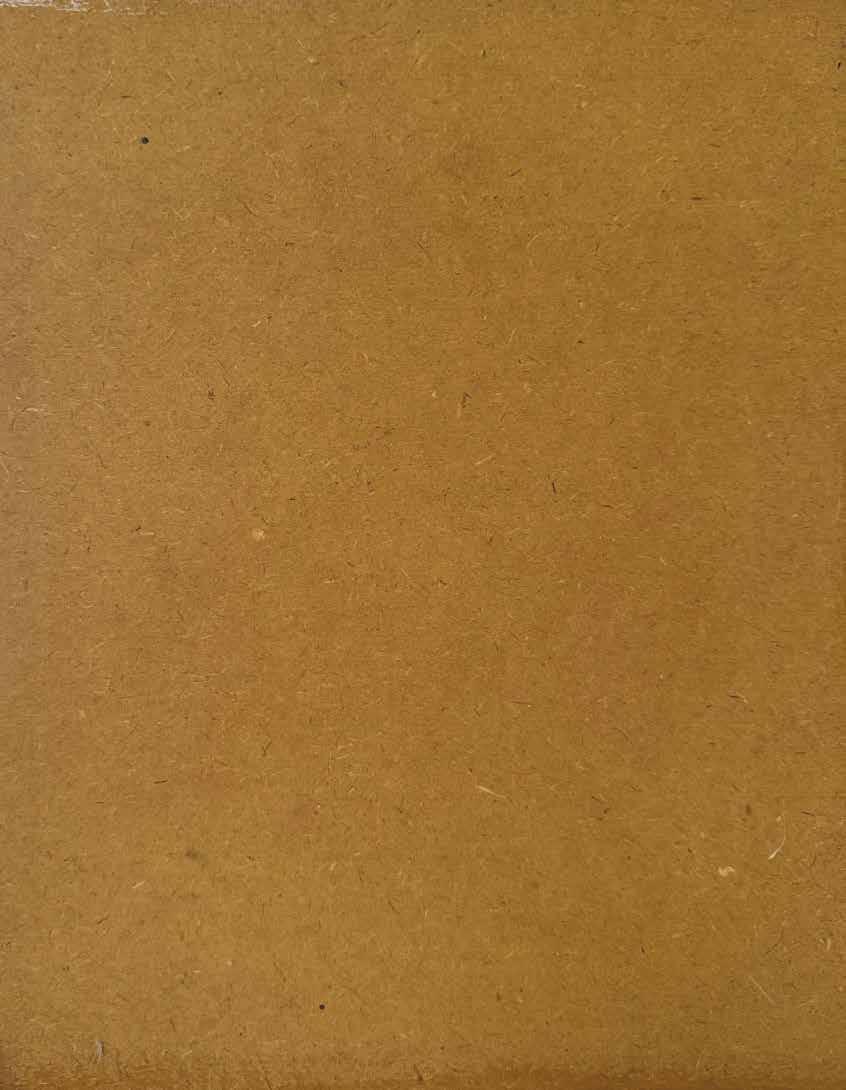





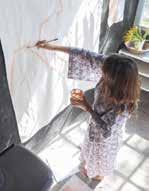

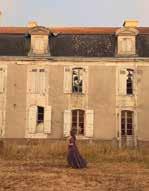

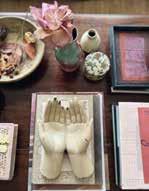

Where do I begin to share my story, to reveal the essence of who I am and what I do? Each page of this book is a reflection of my soul, revealing my pursuits and my inspirations. Join me on this journey where I recount my life as an artist. Let me inspire you, share the beauty in the mundane and encourage you to stand still, observe, marvel and feel.
From a young age, I knew that my destiny was intertwined with the arts and that I wanted to go to the University of the Arts. My childhood was a canvas, and my family painted it with vibrant colours of art, freedom of expression, and exploration of the world. Our home was a playground of imagination, where we tended to our garden, sewed and dyed our own garments, went to ballet lessons and acting classes, and played the piano. We drew and painted every day. My sister and I were exposed to the beauty of the world through visits to museums, exhibitions, and the studios of my parents' artist friends. My fondest memories are of the KröllerMüller Museum in Otterlo, where I spent hours admiring the art. Our family vacations were always spent on the Wadden Island of Ameland. Life was carefree and full of light until I turned sixteen and lost my beloved sister, my other half. The world lost its light for me but my father said: "Tiny, choose the light. Celebrate life." He gave me a coin and said: "Go out and explore the world and if you ever need me, use this coin to call me and I will come and pick you up."
Upon completing my studies at the University of the Arts, Utrecht, I embarked on a journey to Indonesia. My time in Bandung, on the island of Java, proved to be a transformative experience, shaping me both as an individual and as an artist. I was a timid dreamer back then, but my mentor in Bandung saw something in me and urged me to express my innermost thoughts and feelings and tell my story through my art.
In my atelier, Tinystories, I weave a world of optimism and poetry through my paintings and collages. My muses are the beauty of nature, flowers, landscapes, the figures and faces of women, the allure of travel, and the mystique of Asia. I find beauty in the ephemeral, in the imperfect, in the frayed edges of things. Each new piece is accompanied by a verse, a small story told in paint. My art is an extension of my heart, my love, and my soul. Each piece is a visual poem, a delicate reflection of emotion, a dreamy narrative.
Art is a journey, and every journey has a story. This book is a window into my world, an invitation to join me on my journey as an artist. So come along, take my hand and let us travel together on this journey!
With love,



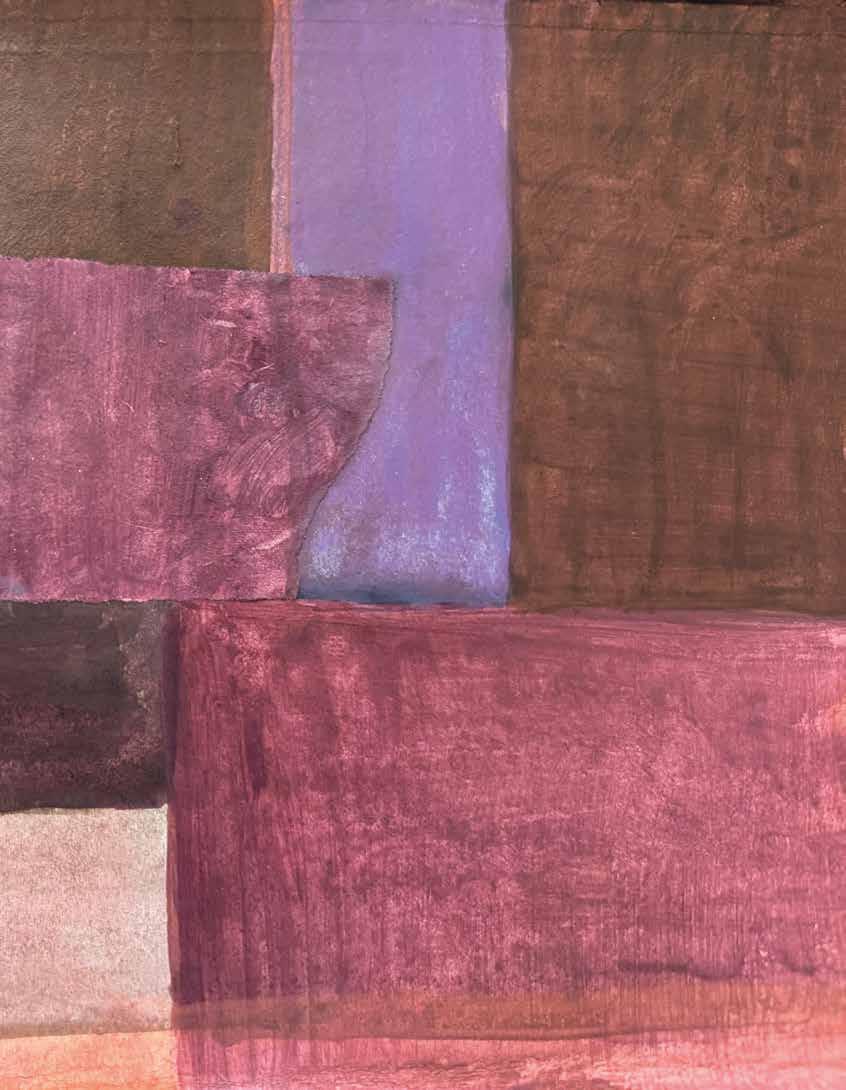

Chop chop chop. As I stir from my slumber, the familiar symphony of breakfast, or lunch, or maybe already dinner being prepared, greets me. In this country the whole day is devoted to preparing and eating food. The birds are chirping in the background, and I hear Elina's dulcet tones along with Alfonzo's slightly warmer timbre. Outside, the hum of mopeds, the splashing of water and the lively calls of street vendors add to the vibrant cacophony. A gentle breeze blows in through the open windows caressing my skin and sending a shiver down my spine. A new day has dawned. Ten minutes later, I find myself seated with a steaming bowl of rice and vegetables before me. Elina pours herself a cup of tea. Aldhira, the eldest son, has made coffee especially for me. The elderly house cat brushes against my bare legs causing a tickling sensation that brings a smile to my face. I feel content, as if I am right at home.
Three months – that's how long I should have stayed, but fate had other plans in store for me and I ended up staying several years. As a student at the University of the Arts in Utrecht I had arranged a place at the art school in Bandung, never imagining what lay ahead. "Go for it! Indonesia is beautiful," my father said. Oh, my father! He sent me out into the big, wide world, telling me he would always be there for me. Perhaps this is why I am so fearless? And so I went with visions of Indonesia as a land of sandy streets with white art deco buildings and tropical greenery. Reality proved different.
As I step off the train in Bandung, I am met with an overwhelming cacophony of noise and dirt. I walk past one cheap hostel after another, drop my rucksack at one of the hostels and go in search of a phone box,
as this was a time before mobile phones. I call Alfonzo from the post office. When I hear his voice, I breathe a sigh of relief. "Just come on over to our house, you are truly welcome,” he says. I take a taxi to a completely different area of the city where I finally see the historical houses of my imagination. Most are shabby with vines and foliage entwining the crumbling walls.
Alfonzo and Elina's beautiful old abode is a white stone house, its huge roof protruding beyond the walls to form a shady veranda. Inside, the ceilings are high and cool brown tiles provide respite from the heat. A cooling breeze blows through the slatted windows. A large palm tree stands proudly in front of the house. Out back in the courtyard garden, tall trees and tropical plants vie for attention. The prominent durian tree is the great pride of Elina’s mother, she will tell me later. Nestled at the rear of the garden lies a low building which serves as a residence for students and bustles with activity. Solitude is an alien concept here.
Alfonzo and Elina reside with their two sons and Elina's mother. Two aunts live here too. I remember the cosy afternoons when the house was filled with the chatter of Elina's mother and her friends as they converse in a mix of Indonesian and Dutch and drink tea with homemade bokkenpootjes – a traditional Dutch biscuit.


My stay here is a profound odyssey that was forever to leave an indelible imprint on my soul. I embrace the adventure with open arms. Within two months with the help of Elina's mother, I have mastered the language reasonably well and I feel more at one with the people here. In my mind I am one of them. But Alfonzo chuckles at that. "You smell of cheese," he teases. In those early days at their home, he introduces me to a world of new flavours. Together we venture to the market to buy fresh fruit, and each day I discover more about the Indonesian cuisine and savour new delicacies. They beam with pride when I exclaim excitedly at the rapturous tastes. After two weeks, the scent of cheese I exuded is but a distant memory.
In no time at all I find myself woven into the fabric of Alfonzo's family. We journey together, visiting their artistic circle and creating memories. They, in turn, become my family. As the years pass, the bond becomes stronger. Adhika, their youngest son, will live with me for three months when he is in the Netherlands for his internship, and my children have now become good friends with the two children and are in almost daily contact. Our bond is unbreakable – a testament to the power of family and friendship.
portrait. Though I learn much at the academy, it is here, among the people, that I truly grow. We lift each other up, helping each other instead of competing. I flit from class to class, immersing myself in the world of art and local crafts.
The next day, I accompany Elina to her friend’s batik workshop. My heart sings as I wander through the vibrant space. Batiked fabrics and exquisite ikat cloths flutter on long lines, their intricate patterns mesmerising me. I marvel at the craftsmanship on display. From a young age I have always been enamoured with all kinds of fabrics. I collected them, treasured them and even began sewing my own clothes from self-dyed fabrics at the tender age of twelve. My love for embroidery knew no bounds as I painted with thread creating wild, untamed patterns. No neat cross-stitches in a predetermined, regular pattern for me.
I watch, entranced, as Elina's friend applies hot wax to the fabric with a metal stamp. This ancient technique of batik where the paint doesn’t stick to the waxed sections thus creating intricate design calls to me. How I long to learn, to perfect the art. I imagine I would need to come here every day for a year to learn batik to perfection and to be able to design my own stamp patterns. For now, I am content to watch and listen to Elina converse with her friend. To be inspired. That afternoon, I paint orchids in the colours of the batik fabrics. Deep purple, aubergine, brick red, and a smidgen of white.
I startle from my reverie over my bowl of rice with the realisation that I have to leave for university and work on my graduation project – an album about a woman who practices Jamu, a traditional Javanese medicine. This herbal drink, passed down from mother to daughter, boosts the immune system with its secret recipe. I accompany her on her early morning rounds through the kampung’s narrow streets as she visits her clients. I photograph her, make screen prints and paint her
Elina and Alfonzo, a university lecturer, are sources of knowledge and inspiration. They open my eyes to the wonders of art, crafts, history, and the intricacies of life. Alfonzo inspires me, urging me to express my own stories through the strokes of my paintbrush. Together, we visit the studio of a friend of Elina's where paper is made from the banana tree. The threads of the trunk are ground and chopped into pulp, mixed with water and glue and shaken out in a sieve to release the water. The sheets are then laid out in the sun to dry. They turn what is essentially waste, into beautiful paper. I purchase an array of sizes and colours of this banana tree paper and



later take it to Emmy's castle in France where I create my own paintings.
Elina is a ceramist. She runs her own ceramics studio where she teaches her craft. One summer we had the pleasure of making mugs in her studio. Working with her was an absolute delight. The clay, sourced from Sukabumi, had a beautiful hue. We experimented with a variety of homemade glazes, creating tones in shades of brown, red, and dark green, reminiscent of the warm landscapes of Java.
The Javanese people have a deep connection with nature and a rich history of craftsmanship. They use the resources available to them to perfect their craft with love and devotion, creating truly beautiful works of art.
The work I create in Bandung overflows with love. Love for this land, its nature, and its people. Smiles greet me at every turn. Here, I learn the unspoken rule of not touching, but offering a smile as a gesture of warmth instead. Beauty surrounds me. Clothed in my kimono, I wander the streets in the early morning light, plucking fragrant frangipane flowers. Their sweet scent fills my senses. The locals greet me, and I strike up a conversation with two women strolling down Jalan Mangga in our shared language of Indonesian. They reveal the secret of finding the best blooms – by reaching for the overhanging branches. Verdant plant tendrils weave their way through the urban landscape as plant cuttings sprout from halved plastic bottles. The lush greenery creeps up to the doorsteps. I meander through the streets making my way to the yoghurt shop I frequent. The plentiful stalls lining the streets are a testament to the resilience of the people as they strive to make a living in a world that isn’t always kind. I see it all and I know – life here is a beautiful struggle.
I am often inspired to capture the essence of Javanese women in my paintings. Their gentle gaze, always accompanied by a warm smile, exudes serenity and modesty. Yet, beneath this calm exterior lies a strength and determination that is evident wherever I go.
As an artist, I revel in the chaos of creation. My palette is a riot of colours, each hue vying for attention in a sea of trays and old sheets of paper. I am drawn to the texture of handmade paper and India ink and like to make collages using these. My painting 'Follow Rivers' is a testament to this process – a portrait of a woman, her visage emerging from a collage of sheets and colour. The name is a reflection of my approach to life, one that embraces the unexpected and revels in the unknown. I experiment with paints that shouldn't work together, watching as they clash and melt in unexpected ways. I leave my work unvarnished, allowing the colours to fade over time until only the black of the ink remains. To me, this is where the magic lies.
Bandung holds a special place in my heart, a place where I know I will always be embraced with open arms. It is a home away from home where I am surrounded by the warmth of family. For family is the foundation of everything and in Bandung I am blessed to have found mine.


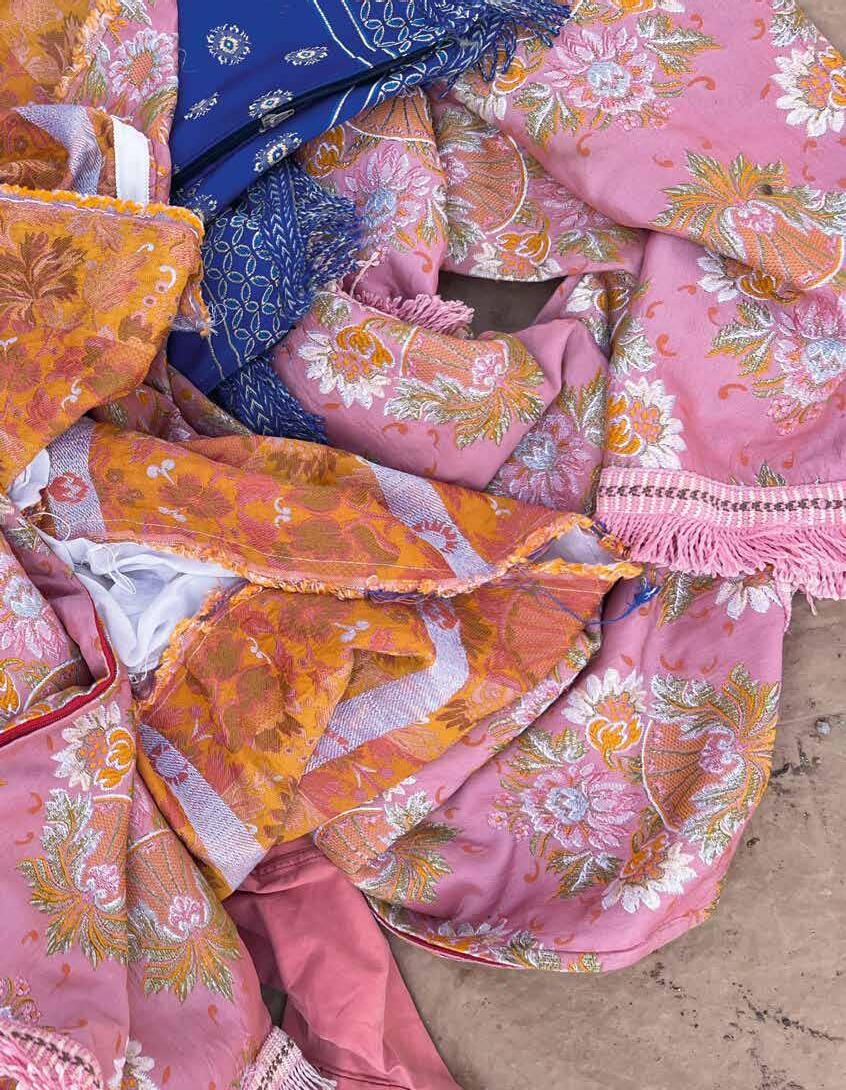

Sitting in the back of an old Volkswagen, the sun is shining. The car bounces along a road which is pitted with potholes. I see the landscape fly by as if it were a fast-motion slideshow. In the front, my friend Nadia and her father are talking and laughing. I can’t understand what they are saying but I hear the cadence of their voices and know that they are happy to be together again. Nadia’s father is taking us to his favourite café in Tanger for breakfast, where we eat warm, freshly baked flatbread with amlou, an essentially liquid paste made from ground toasted almonds with honey and oil. I feel incredibly welcome. Nadia’s father is proud and happy. He wants to show me his beautiful country, he says.
This initial journey marked the beginning of a love affair with the country, one that would captivate my heart over the ensuing years, enchanting me with its vibrant hues and evocative aromas. A land where I would revel in the radiance of its hospitality and the genuine warmth of its people. It soon emerged as a wellspring of inspiration for several artworks to come. The colours on my canvas deepened, imbued with a new-found intensity and warmth.
That first time, I immersed myself in all that Morocco had to offer, nature- and culture-wise. I pretended to be Moroccan, talking to everybody using hands, feet and my brushes. When I painted, people would often approach me and ask what I was doing, and a conversation would ensue naturally, sometimes with words, sometimes just with a sense of connection and a smile. I walked along the surf on the long, beautiful, vast beaches. Donkeys accompanied me. Rubbish was littered everywhere, and the sand was a sallow brown colour. This made no odds – it is what it is. This is how the people live here.
Years later, I find myself wandering through the bustling, sprawling open-air market, situated thirteen miles beyond Marrakech. More than a hundred stalls, tightly clustered together, sprawl across an expanse covering half a square mile. Narrow pathways wind between them, shaded by canvas coverings overhead. Donkeys and sheep are tethered nearby, while vendors clad in traditional attire linger amidst the lively exchange of bids and counterbids. The week’s bounty is proudly displayed upon rugs and plastic sheets: an array of vegetables, potatoes, and various round root vegetables, alongside a cornucopia of fruits and nuts. Within a designated area, pottery, handmade doors, assorted used parts, wooden furniture and detergent are on offer, including the Moroccan black hamam soap. Fresh herbs and spices, boasting vivid hues, tantalise the senses, while the scent of sizzling meat over open fires intermingles at the back with the smoky aroma lingering in the air. Amidst this vibrant scene, men gather in mud huts, seated together on the floor, as they pour sugary-sweet tea into cups.





